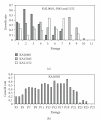Assessment of transformed properties in vitro and of tumorigenicity in vivo in primary keratinocytes cultured for epidermal sheet transplantation
- PMID: 21188234
- PMCID: PMC3003988
- DOI: 10.1155/2011/936546
Assessment of transformed properties in vitro and of tumorigenicity in vivo in primary keratinocytes cultured for epidermal sheet transplantation
Abstract
Epidermal keratinocytes are used as a cell source for autologous and allogenic cell transplant therapy for skin burns. The question addressed here is to determine whether the culture process may induce cellular, molecular, or genetic alterations that might increase the risk of cellular transformation. Keratinocytes from four different human donors were investigated for molecular and cellular parameters indicative of transformation status, including (i) karyotype, (ii) telomere length, (iii) proliferation rate, (iv) epithelial-mesenchymal transition, (v) anchorage-independent growth potential, and (vi) tumorigenicity in nude mice. Results show that, despite increased cell survival in one keratinocyte strain, none of the cultures displayed characteristics of cell transformations, implying that the culture protocol does not generate artefacts leading to the selection of transformed cells. We conclude that the current protocol does not result in an increased risk of tumorigenicity of transplanted cells.
Figures





References
-
- Rheinwald JG, Green H. Serial cultivation of strains of human epidermal keratinocytes: the formation of keratinizing colonies from single cells. Cell. 1975;6(3):331–334. - PubMed
-
- Faure M, Mauduit G, Schmitt D, Kanitakis J, Demidem A, Thivolet J. Growth and differentiation of human epidermal cultures used as auto- and allografts inhumans. British Journal of Dermatology. 1987;116(161):p. 170. - PubMed
-
- Hahn WC, Counter CM, Lundberg AS, Beijersbergen RL, Brooks MW, Weinberg RA. Creation of human tumour cells with defined genetic elements. Nature. 1999;400(6743):464–468. - PubMed
-
- Larsen C-J. pRB, p53, p16INK4a, senescence and malignant transformation. Bulletin du Cancer. 2004;91(5):399–402. - PubMed
LinkOut - more resources
Full Text Sources

